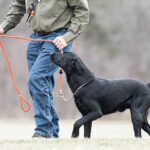Table of Contents
Training a dog for obedience trials requires dedication, consistency, and the right techniques. Obedience trials test your dog’s ability to perform a variety of tasks with precision and responsiveness. This guide provides expert tips on training a dog for obedience trials to help you and your canine companion succeed in competition. Here are seven tips to get you started.

1. Understand the Requirements of Obedience Trials
Before you start training, familiarize yourself with the requirements of obedience trials:
- Exercises and Commands: Learn the specific exercises and commands that will be tested in the trial, such as heeling, recalls, sits, downs, and stays.
- Scoring Criteria: Understand the scoring system and what judges look for in terms of precision, attitude, and teamwork.
- Trial Rules: Be aware of the rules and regulations governing the trial, including allowable equipment and handler conduct.
Understanding the requirements helps you tailor your training to meet the standards expected in obedience trials.
2. Start with Basic Obedience Training
Build a strong foundation with basic obedience training:
- Basic Commands: Teach your dog basic commands such as sit, stay, down, come, and heel.
- Positive Reinforcement: Use positive reinforcement techniques, such as treats, praise, and play, to encourage desired behaviors.
- Consistency: Be consistent with commands and rewards to reinforce learning.
A solid foundation in basic obedience is essential for progressing to more advanced trial exercises.
3. Introduce Advanced Commands and Exercises
Once your dog has mastered basic obedience, introduce advanced commands and exercises:
- Precision Heeling: Work on precise heeling, ensuring your dog stays in the correct position and responds promptly to changes in direction and pace.
- Recall with Finish: Train your dog to come when called and finish by sitting in front of or beside you.
- Drop on Recall: Teach your dog to drop to the ground on command while in motion during a recall.
Advanced commands and exercises prepare your dog for the specific tasks required in obedience trials.
4. Use Distraction Training
Prepare your dog to perform reliably in different environments by incorporating distraction training:
- Gradual Exposure: Gradually introduce distractions such as other dogs, people, noises, and varying environments.
- Controlled Distractions: Start with mild distractions and gradually increase their intensity as your dog becomes more proficient.
- Focus Training: Teach your dog to maintain focus on you despite distractions by using attention exercises and rewarding eye contact.
Distraction training helps your dog stay focused and responsive during the trial.
5. Practice in Different Environments
Simulate trial conditions by practicing in various environments:
- Public Places: Practice in parks, pet stores, and other public places to get your dog used to different settings.
- Trial Venues: If possible, practice at the actual trial venue or a similar location to familiarize your dog with the environment.
- Varying Surfaces: Train on different surfaces, such as grass, pavement, and indoors, to prepare your dog for any trial conditions.
Practicing in different environments ensures your dog can perform confidently regardless of the setting.
6. Focus on Handler-Dog Communication
Effective communication between you and your dog is crucial for success in obedience trials:
- Clear Signals: Use clear and consistent signals for commands, whether verbal or hand signals.
- Positive Reinforcement: Reinforce your dog’s understanding of commands through positive reinforcement and timely rewards.
- Teamwork: Build a strong bond and trust with your dog through regular training and positive interactions.
Strong communication enhances your dog’s responsiveness and precision during trials.
7. Join Obedience Classes or Clubs
Joining obedience classes or clubs can provide valuable support and resources:
- Professional Guidance: Receive guidance from experienced trainers who can help address specific challenges and refine your techniques.
- Group Training: Benefit from group training sessions that offer exposure to different dogs and environments.
- Networking: Connect with other handlers and competitors to share tips, experiences, and support.
Obedience classes and clubs provide a structured environment for training and opportunities for socialization and learning.
Conclusion on Training a Dog for Obedience Trials
Training a dog for obedience trials requires dedication, patience, and a strategic approach. By following these tips on training a dog for obedience trials, you can prepare your canine companion for success in competition. Understand the requirements, start with basic obedience, introduce advanced commands, use distraction training, practice in different environments, focus on communication, and join obedience classes or clubs. For more information on obedience training and trials, visit the AKC and UKC.
FAQs on Training a Dog for Obedience Trials
What are obedience trials?
Obedience trials are competitions where dogs perform a series of exercises designed to demonstrate their training, responsiveness, and teamwork with their handler.
How long does it take to train a dog for obedience trials?
The time required varies depending on the dog’s age, breed, and prior training. Consistent training over several months to a year is typical for preparing a dog for obedience trials.
What breeds are best for obedience trials?
While any breed can participate, some breeds like Border Collies, German Shepherds, and Golden Retrievers are known for excelling in obedience due to their intelligence and trainability.
Can older dogs compete in obedience trials?
Yes, older dogs can compete in obedience trials. Training may need to be adapted to accommodate any physical limitations, but many senior dogs perform well in trials.
What equipment is needed for obedience training?
Basic equipment includes a collar, leash, treats for positive reinforcement, and various props for specific exercises, such as jumps or scent articles.
How do I find obedience trials to enter?
Check with organizations like the AKC and UKC for listings of upcoming trials. Local dog training clubs and obedience classes may also have information on trials in your area.











